MARIANI’S
Virtual Gourmet
October
30, 2016
NEWSLETTER
HAPPY
HALLOWEEN!
IN THIS ISSUE
WINSTON-SALEM, SC
By John Mariani
NEW YORK CORNER
STRIP HOUSE
By John Mariani
NOTES FROM THE WINE CELLAR
WHAT I'M DRINKING NOW
By John Mariani
❖❖❖
WINSTON-SALEM, SC
By John Mariani
Back in 1977 on our 14-week
transcontinental honeymoon, as my wife and I
approached the outskirts of Winston-Salem, the
smell of cured and roasted tobacco drifted through
the air and got stronger as we got closer to the
city. The
aroma was sweet, like the burning of leaves in
autumn, and instantly recognizable.
In those days Winston-Salem was
dominated by the vast holdings of The R. J. Reynolds
Tobacco Company, which
in the 1940s employed 60  percent of the city’s
workers, who nicknamed the town “Camel City” after
the company’s best known brand. Today that tobacco aroma is gone, and
the cigarette factories are, too. But
Winston-Salem had always had so much more that its
people could build on, so that today it’s one of the
loveliest and diverse cities in the South, with
about 250,000 inhabitants.
percent of the city’s
workers, who nicknamed the town “Camel City” after
the company’s best known brand. Today that tobacco aroma is gone, and
the cigarette factories are, too. But
Winston-Salem had always had so much more that its
people could build on, so that today it’s one of the
loveliest and diverse cities in the South, with
about 250,000 inhabitants.
Salem dates back to 1753 as a
Moravian settlement, founded at the three forks of
Muddy Creek, and the preservation and restoration of
the little town still goes on as Old Salem Museums
& Gardens, built around Salem Square and
expanding outwards to include a passel of trim,
wood, brick and lathe structures, others with arched
hoods (left),
and others a mix of styles that evolved over
decades, like the original Winkler Bakery (below).
The connection to the name
“Winston” derived from the establishment of a new
settlement in 1851 named after Revolutionary War
figure Joseph Winston. Only as of the Civil War were
non-Moravians allowed to live in the town, which was
incorporated in1856, and by the 1880s the U.S. Post
Office made the name “Winston-Salem” official. 
The
well-drained soil and warm climate in this part of
North Carolina were ideal for tobacco farming, so in
1875 Richard Joshua Reynolds, a Virginian, erected
his first factory, quickly followed by forty more,
so that despite the onus that tobacco production now
suffers under, North Carolina is still the largest
producer, with around 1,800 tobacco farms. Reynolds
would name its products Winston, Salem, and Doral. Its
stunning art deco headquarters (left), erected
in 1929 just as the Depression hit, was the tallest
building in the country south of Baltimore. (It is
now a Kimpton hotel.)
The continuing prosperity of
Winston-Salem seemed assured until the tobacco and
textile industries began to wane in the 1970s, so
the city wisely decided that its future was in the
medical, hi-tech, and bio-tech industries, led by
the Wake Forest Innovation Quarter, with more than
60 companies and 3,100 workers; the Wake Forest
Baptist Medical Center is today the city’s largest
employer.
The principal touristic draw to
the city is the wonderful Old Salem Museums &
Gardens, which is a true restoration rather than a
recreation like Williamsburg, Virginia. It is easy
enough to navigate on a self-guided tour, poking
your way into the solid old buildings, traversing
the grounds and the remarkable gardens that evoke
the significant horticultural advances of the
Moravians from 1766 to 1856. Each
dwelling had its own fenced-in
garden area, and they flourish with historic plants
and open-pollinated heirloom vegetables and trees;
careful attention is paid to preserving their
diverse seeds for future generations as well as
sharing them with other horticultural programs.
(Tours of the Gardens are available by calling
1-800-441-5305.)
A Cobblestone Farmers Market (left) culls
products from Northwest Piedmont farms each Saturday
from April to November.
fenced-in
garden area, and they flourish with historic plants
and open-pollinated heirloom vegetables and trees;
careful attention is paid to preserving their
diverse seeds for future generations as well as
sharing them with other horticultural programs.
(Tours of the Gardens are available by calling
1-800-441-5305.)
A Cobblestone Farmers Market (left) culls
products from Northwest Piedmont farms each Saturday
from April to November.
The Old Salem Winkler
Bakery is still in operation (though it’s
moved around over 200 years), along with ovens in
two other houses, and you can buy their products
just minutes off the heat, the air perfumed with the
smell of yeast and brown bread. In other
buildings, like the Miksch House (below), there
is a good deal of cooking going on by women in
period dress, where you may watch lessons in
traditional Moravian foods cooked with resolutely
Moravian methods and utensils, including
creamed spinach with egg whites
beaten by a straw whisk, fruit pies baked in a Dutch
oven, and wine-laced syllabub.
egg whites
beaten by a straw whisk, fruit pies baked in a Dutch
oven, and wine-laced syllabub.
While slavery had been tolerated
in Salem, by 1822 the settlement had its own
African-American Moravian church, now called the St. Philips Heritage
Center, from whose pulpit a Union Cavalry
Chaplain announced the emancipation of slaves on May
21, 1865.
There’s much more to see
throughout Old Salem—the magnificent Tannenberg
Organ, here for more than a century; a book and gift
shop; a hat shop that sells pottery and handmade
baskets as well; a gunsmith shop, and the Museum of
Early Southern Decorative Arts that exhibits the
story of the South through its furniture, ceramics,
silverware and artwork.
Beyond Old Salem, the city has
built up a vibrant restaurant scene I shall be
reporting on in my next newsletter. There
also is the requisite Children’s Museum, and the
Downtown Arts District is rife with galleries, along
with the Elberson Fine Arts Center and a Piedmont
Craftsmen Gallery.
 One of the
most unexpectedly grand sites to visit is the Reynolda House Museum
of American Art (left), once the 1917 home of the
R.J. Reynolds family, which had for so long
dominated Winston-Salem. Rambling over landscaped
gardens and greenery, up and down staircases through
vast rooms of exquisite design and antiques, the
edifice also houses one of the most extraordinary
privately acquired collections of art in America, so
when you enter any room you come face to face with
some of the most famous artists’ most famous
works—John Singleton Copley, Albert Bierstadt, Mary
Cassatt, Frederic Church, Georgia O’Keeffe, Thomas
Eakins, Grant Wood.
Opposite
Reynolda is the Southeastern Center for Contemporary
Art, once the home of textile industrialist James G.
Hanes. There is also a superb collection of
African-American art in the Diggs Gallery at
Winston-Salem State University, and the beautifully
designed and landscaped Wake Forest University,
founded in 1834, is home to the 129-acre Reynolda
Gardens established by the Reynolds family.
One of the
most unexpectedly grand sites to visit is the Reynolda House Museum
of American Art (left), once the 1917 home of the
R.J. Reynolds family, which had for so long
dominated Winston-Salem. Rambling over landscaped
gardens and greenery, up and down staircases through
vast rooms of exquisite design and antiques, the
edifice also houses one of the most extraordinary
privately acquired collections of art in America, so
when you enter any room you come face to face with
some of the most famous artists’ most famous
works—John Singleton Copley, Albert Bierstadt, Mary
Cassatt, Frederic Church, Georgia O’Keeffe, Thomas
Eakins, Grant Wood.
Opposite
Reynolda is the Southeastern Center for Contemporary
Art, once the home of textile industrialist James G.
Hanes. There is also a superb collection of
African-American art in the Diggs Gallery at
Winston-Salem State University, and the beautifully
designed and landscaped Wake Forest University,
founded in 1834, is home to the 129-acre Reynolda
Gardens established by the Reynolds family.
You can
actually stay and dine in the  Graylyn Estate International Hotel &
Conference Center, once the baronial home
of James Alexander Gray, former president of R.J.
Reynolds, spread over 55 acres and now owned and
managed by Wake Forest. Its mix of architectural
design includes everything from Medieval towers to
homes that look like English country manor houses;
the interior is full of imports like the 15th
century French carved doorway and Louis XV paneling,
renaissance fireplaces and suits of armor, and
extraordinary wrought-iron staircases under a
soaring cupola.
Graylyn Estate International Hotel &
Conference Center, once the baronial home
of James Alexander Gray, former president of R.J.
Reynolds, spread over 55 acres and now owned and
managed by Wake Forest. Its mix of architectural
design includes everything from Medieval towers to
homes that look like English country manor houses;
the interior is full of imports like the 15th
century French carved doorway and Louis XV paneling,
renaissance fireplaces and suits of armor, and
extraordinary wrought-iron staircases under a
soaring cupola.
Certainly not last among
Winston-Salem’s pleasures is the opportunity to see
the preparation and baking of the paper-thin cookies
at Mrs. Hanes’
Moravian Cookies (below) in the
suburb of Clemmons.
Here, after seven generations, Evva Hanes
oversees two or three generations of exceedingly
dedicated, hair-netted women who appear to have
stepped out of 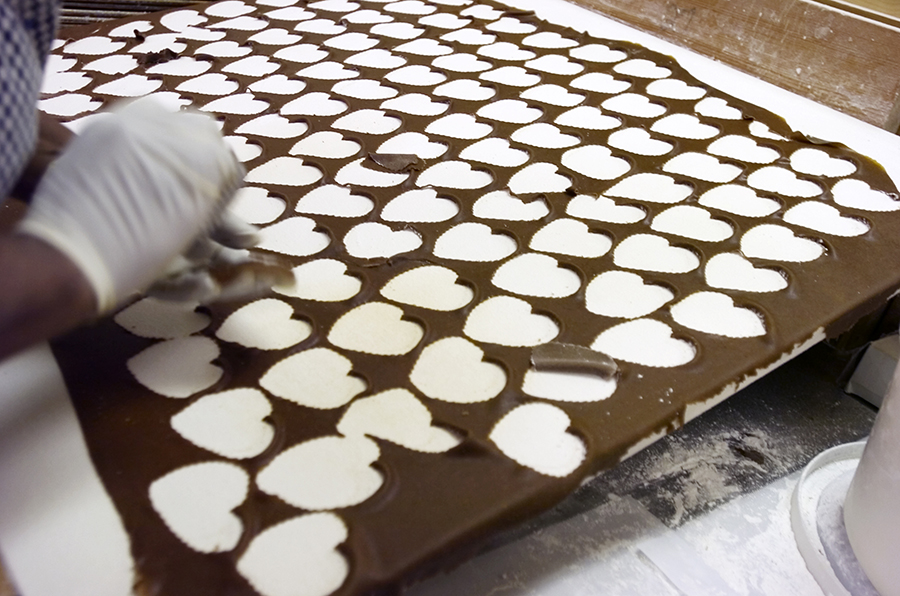 “American
Gothic.” They
stand at their tilted tables, working gingersnap,
molasses, lemon, chocolate and walnut dough into
near-sheer sheets, always the same precise thinness,
then they cut them out with their own treasured
stamps to be baked so that the little factory always
smells like Christmas. One hundred ten thousand
pounds of dough goes through their hands, some
packaged weeks in advance of the barrage of holiday
orders and shipped all over the U.S. and to 30
countries abroad.
“American
Gothic.” They
stand at their tilted tables, working gingersnap,
molasses, lemon, chocolate and walnut dough into
near-sheer sheets, always the same precise thinness,
then they cut them out with their own treasured
stamps to be baked so that the little factory always
smells like Christmas. One hundred ten thousand
pounds of dough goes through their hands, some
packaged weeks in advance of the barrage of holiday
orders and shipped all over the U.S. and to 30
countries abroad.
There is,
then, a great deal of history about Winston-Salem
that extends beyond the indelible footprint of the
tobacco industry, which by fading in importance has
allowed the true substance of the city to shine
through in all aspects of Southern hospitality.
❖❖❖
By John Mariani
 STRIP HOUSE
STRIP HOUSE13 East 12th Street (near Fifth Avenue)
212-328-0000
“You gotta get a gimmick,” sang the
strippers in “Gypsy,” and it’s a good philosophy
in a business as traditional as that of steakhouse
chains, whose scruffy décor largely follows
clichés set long ago by NYC totems like Palm,
Peter Luger and Smith & Wollensky.
The original owners of Strip
House, Peter and Penny Glazier, (now with
four locations, three in NYC, owned by BR Guest
Hospitality) took the “Gypsy” ladies’ advice by
having architect David Rockwell fashion a room
riotously red and festooned with hundreds of
original Studio Manasse 1930s prints of burlesque
stars. It’s
all meant in naughty fun, even though, after two
decades, it has taken on a patina of nostalgic
innocence, and no woman I have ever dined with
here has ever taken offense to the décor.
There are cushy, tufted
banquettes, big tables with flip-up extenders, and
thick 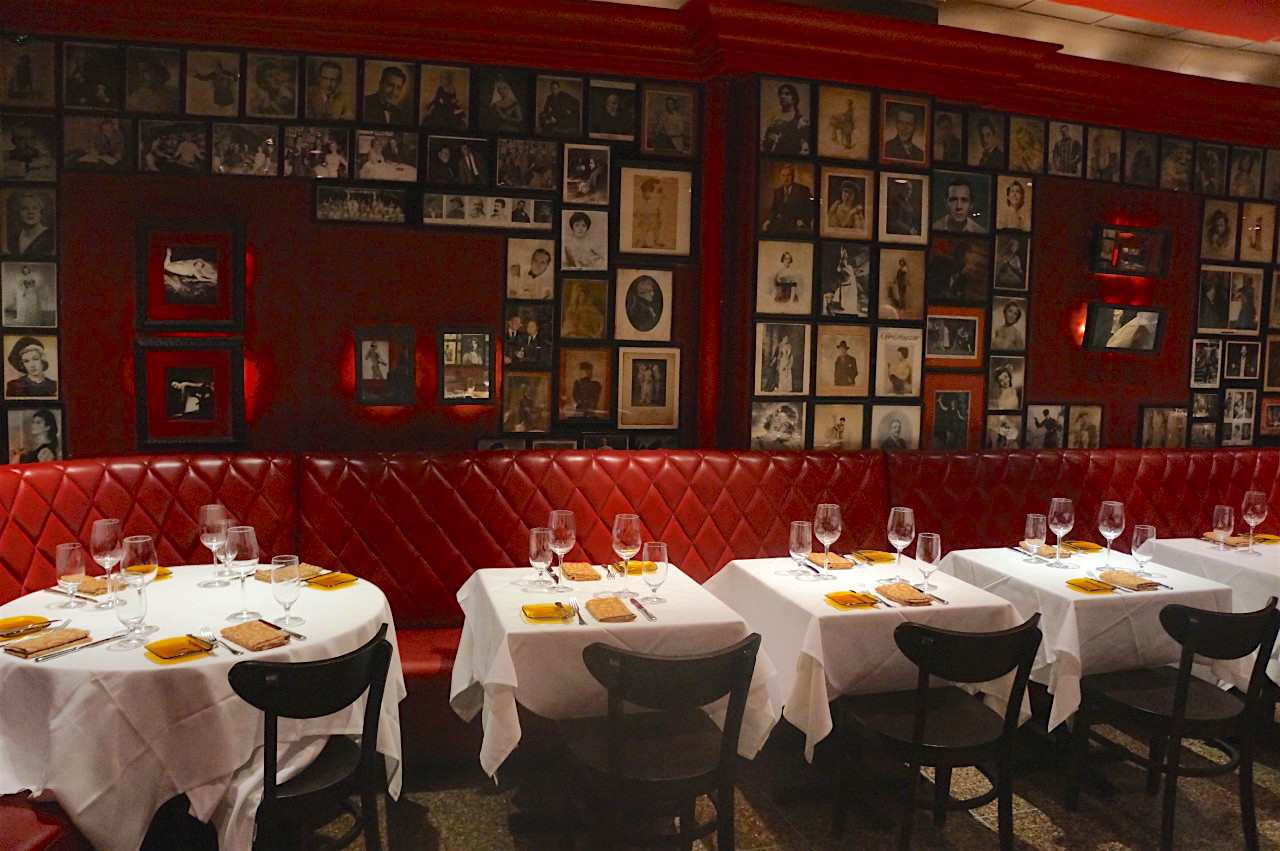 white
double tablecloths; the sound level is remarkably
good in a room filled largely with shirtsleeve
guys whose normal tone of voice is loud. The
waiters are very friendly and informative, rather
than mere menu reciters, and, since the menu,
under Corporate Executive Chef Michael Vignola,
doesn’t change very much, you can be assured that
most of the items have been brought to a
consistent level of excellence in the cooking
process. Ask
for your meat with a good char outside and
medium-rare inside, and that’s what you’ll get. Pity
the bartender doesn’t even possess a fruit press
to make fresh juice for the cocktails (you can buy
a squeezer for about ten bucks), despite their
costing $16-$24.
white
double tablecloths; the sound level is remarkably
good in a room filled largely with shirtsleeve
guys whose normal tone of voice is loud. The
waiters are very friendly and informative, rather
than mere menu reciters, and, since the menu,
under Corporate Executive Chef Michael Vignola,
doesn’t change very much, you can be assured that
most of the items have been brought to a
consistent level of excellence in the cooking
process. Ask
for your meat with a good char outside and
medium-rare inside, and that’s what you’ll get. Pity
the bartender doesn’t even possess a fruit press
to make fresh juice for the cocktails (you can buy
a squeezer for about ten bucks), despite their
costing $16-$24.
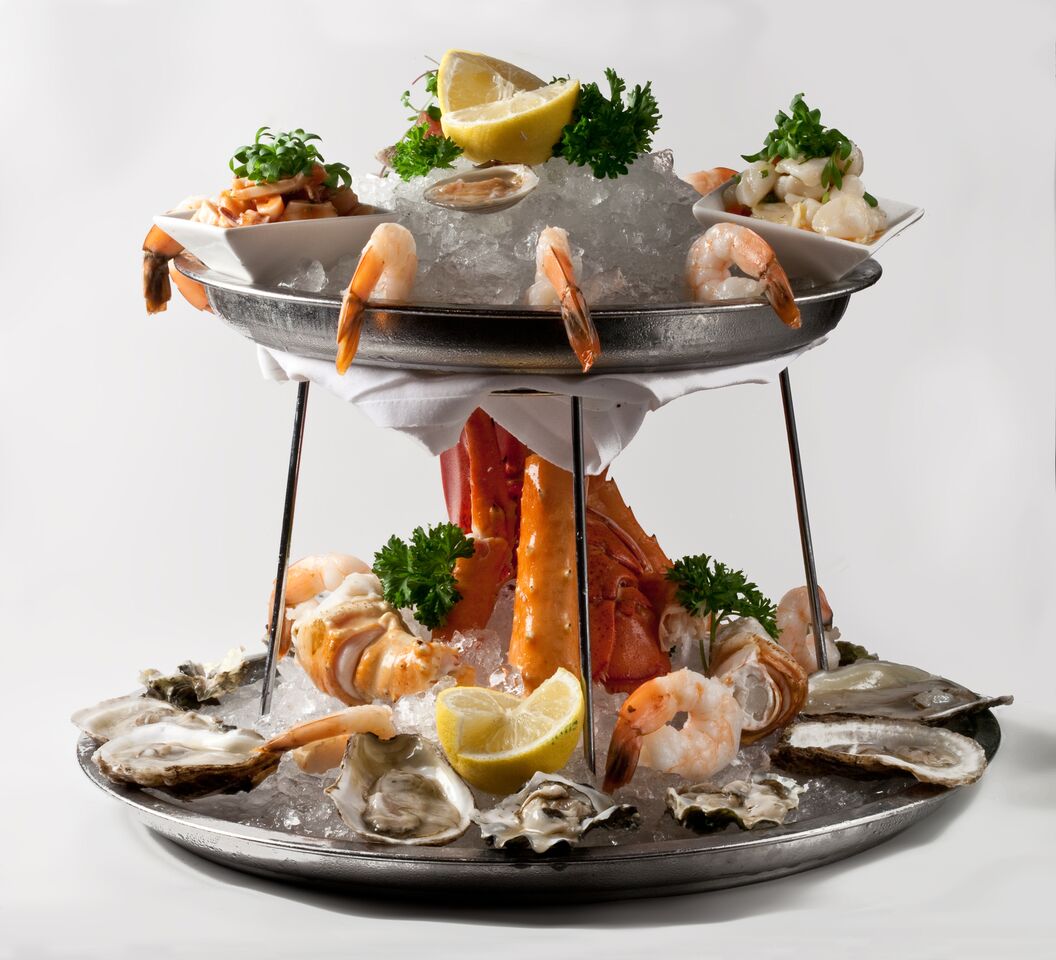 Aside
from a couple of signature items, like the highly
recommended bocce ball-sized goose fat-fried
potatoes ($13) that will easily feed two people,
dishes don’t differ in name from most steakhouses
around town.
But I do think Strip House’s roasted bacon
($18), with egg, crispy capers and a frisée salad,
the very best I’ve enjoyed anywhere, and the lump
crab cake, with potato salad, green beans, corn
salsa and remoulade ($19), was as fine as any.
Aside
from a couple of signature items, like the highly
recommended bocce ball-sized goose fat-fried
potatoes ($13) that will easily feed two people,
dishes don’t differ in name from most steakhouses
around town.
But I do think Strip House’s roasted bacon
($18), with egg, crispy capers and a frisée salad,
the very best I’ve enjoyed anywhere, and the lump
crab cake, with potato salad, green beans, corn
salsa and remoulade ($19), was as fine as any.
I’ve become spoiled down South
by fresh shrimp, but if I can’t get them I’ll
happily order the jumbo shrimp cocktail at Strip
House ($20), as I would the jumbo crabmeat
cocktail ($20). The spicy tuna tartare ($19) comes
with generous chopped avocado, cucumber, wasabi
roe and radish sprouts.
At a time when USDA Prime beef
has become tougher and tougher to come by (just as
enormous herds of supposed wagyu and kobe beef
seem to be inundating steakhouses), the virtue of
being a long time in the NYC market and having
three locations there gives Strip House clout. So
the  beef has
the intense flavor and juiciness you expect from
the top of the breed, especially the New York
strip ($49 for 16 ounces, $58 for a bone-in cut),
but the dry-aged strip at 14 ounces ($48) is even
better. The porterhouse for two runs $60 per
person (you’ll take some home), but the best dish
on this section of the menu is a terrific Colorado
lamb duo ($42), which comes as a roasted double
chop and smoked shoulder. And, since all the
steaks come naked on a plate, the inclusion of
roasted squash, market bean fricassee and marjoram jus to
this lamb dish makes it all the more appealing.
beef has
the intense flavor and juiciness you expect from
the top of the breed, especially the New York
strip ($49 for 16 ounces, $58 for a bone-in cut),
but the dry-aged strip at 14 ounces ($48) is even
better. The porterhouse for two runs $60 per
person (you’ll take some home), but the best dish
on this section of the menu is a terrific Colorado
lamb duo ($42), which comes as a roasted double
chop and smoked shoulder. And, since all the
steaks come naked on a plate, the inclusion of
roasted squash, market bean fricassee and marjoram jus to
this lamb dish makes it all the more appealing.
You
really don’t need the optional sauces ($3 each)
for these meats, but you should indulge in the
creamed spinach with black truffles ($13), the
creamed corn with pancetta ($12), or the dry aged
herbed onions with a citrus glaze ($14)—all of
these to be shared.
 Of course you don’t
need dessert, though they gussy the usual ones up
a bit here, including pouring and flaming cheap
Sambuca on top of an already blah baked Alaska
($14) that might otherwise be served at a child’s
birthday party.
There’s nothing at all wrong with the
cheesecake ($12), or the warm chocolate brownie
with vanilla ice cream and rich hot fudge sauce
($12), but the signature dessert here is a dense
24-layer chocolate ganache cake ($16) that is more
a tour-de-force than a convincing argument that
more is more.
Of course you don’t
need dessert, though they gussy the usual ones up
a bit here, including pouring and flaming cheap
Sambuca on top of an already blah baked Alaska
($14) that might otherwise be served at a child’s
birthday party.
There’s nothing at all wrong with the
cheesecake ($12), or the warm chocolate brownie
with vanilla ice cream and rich hot fudge sauce
($12), but the signature dessert here is a dense
24-layer chocolate ganache cake ($16) that is more
a tour-de-force than a convincing argument that
more is more.
The wine list offers dozens of
wines by the glass among a formidable screed that
includes a “Library List” of bottlings like La
Tâche 2010 for $2,650 and Échezeaux Grand Cru DRC
2009 at $3,000, as well as a selection of large
format bottles.
Sadly, there aren’t a heck of a lot of
labels on the list under $100, and mark-ups are
very high: $170 for Far Niente 2014, which sells
for under $50 in a store? $140
for Gaja Ca’ Marcanda Promis 2013 that costs
$35-$40 retail? Whew!
For
food alone, Strip House is as good as any in town
and much better than most, but in ambiance and
service it has achieved its own special status
among gourmands, who will never be disappointed
and always well treated. It’s as much fun to
dine there as it is to eat there.
WHAT I'M DRINKING NOW
By John Mariani

“Sorrow can be alleviated by
good sleep, a bath
and a glass of wine.”-- Saint Thomas
Aquinas
 AZELIA BAROLO BRICCO
FIASCO 2011 ($58)—From the Castiglione
Falletto hills estate of Luigi Scavino, this is an
appealingly priced major
Barolo, vinified from 100% Nebbiolo separately
from the winery’s other
Barolos. Made
from old vines, 65
years on average, it has a multiple personality
with richness of fruit and
tannins throughout.
I’d hang on to
it for another couple of years for maximum
pleasure, longer if you have the
time.
AZELIA BAROLO BRICCO
FIASCO 2011 ($58)—From the Castiglione
Falletto hills estate of Luigi Scavino, this is an
appealingly priced major
Barolo, vinified from 100% Nebbiolo separately
from the winery’s other
Barolos. Made
from old vines, 65
years on average, it has a multiple personality
with richness of fruit and
tannins throughout.
I’d hang on to
it for another couple of years for maximum
pleasure, longer if you have the
time.
PAUL HOBBS PINOT NOIR
CATHERINE LINDSAY ESTATE 2012 ($95)—Made
in a prime Laguna Ridge
section of the Russian River Valley, this
admirably complex Pinot Noir comes
from a vineyard named after Paul Hobbs’s great
grandmother, so you know he’s
going to put a lot of respect into the bottle. It is not cheap, though.
CROFT RESERVE TAWNY
PORTO ($18)—Croft is one of the
oldest Port producers in the Douro
Valley, and it
aims at a modern style for its Tawny Ports that
depends not on
brawn but on finesse, earned by time in oak casks. Its aging as a Reserve tames
the tannins of Port stocks that are an
average of seven years old, made from Touriga Nacional, Touriga
Franca, Tinta Barroca, Tinta
Roriz, Tinto Cão
and Tinta
Amarela. All
Ports are relatively good buys, but the Tawnies
are almost
always a bargain, and this one comes in an
attractive new bottle. .
and it
aims at a modern style for its Tawny Ports that
depends not on
brawn but on finesse, earned by time in oak casks. Its aging as a Reserve tames
the tannins of Port stocks that are an
average of seven years old, made from Touriga Nacional, Touriga
Franca, Tinta Barroca, Tinta
Roriz, Tinto Cão
and Tinta
Amarela. All
Ports are relatively good buys, but the Tawnies
are almost
always a bargain, and this one comes in an
attractive new bottle. .
LAPROAIG ISLAY SINGLE MALT SCOTCH WHISKY
LORE ($122)—The
word “lore” on the bottle means “the passing of a
skill or tradition through
word of mouth,” which is fair enough. The
producers have learned a lot since
establishing the distillery in
1815. There are many Scotch lovers who are not
overly fond of the salty, smoky
Islay style, but this finely rendered example hits
a middle ground through
which you can appreciate the distinction of the
smoke but also enjoy it for its
hearty flavors from the tip of the tongue to the
finish on the palate. You can smell it from
across the
room, and it’s the smell of peat and Scottish
heath. I believe it’s out of
stock in the UK but still available here.
MARYHILL MOURVÈDRE
2012 ($34)—Tasting this blind, I’d never
spot it outright as a mourvèdre, but I will
recommend it as a good, medium-bodied red wine
made in
the Sugarloaf Vineyard in Rattlesnake Hills
appellation of Goldendale, CA, with
14.6% alcohol—a hike from the 2011
vintage of 13.1-- it shows promise as a varietal
for the future.
CHÂTEAU ROSLANE PREMIER CRU LES COTEAUX
DE L’ATLAS 2011
($21)—I’ve been accused of being one of those East
Coasters who prefer Bordeaux
when I wish to drink Cabernet blends, and I plead
guilty. What
a surprise, then, that this little
beauty is from Morocco, in the Atlas Mountains, a
blend of Merlot, Syrah and
Cabernet Sauvignon.
Roslane is a
huge winery for Morocco and it shows what goodness
can come out of a desert
terroir.
 CHÂTEAU
DU TAILLAN HAUT-MÉDOC CRU BOURGEOIS 2012
($15)—How
unfortunate to carry the connotations of being a
“Cru Bourgeois,” for it’s a
perfectly acceptable thing for a Haut-Médoc wine
to be, as this assemblage of
70% Merlot, 20% Cabernet Sauvignon, and 10%
Cabernet Franc proves. The lovely chateau dates
back centuries
but this wine has been made since the 1930s, so it
has a consistent record of
good taste. This is one of those bottles you idly
pick off the shelf for an
autumn meal of lamb stew and find you finish the
bottle with remarkable ease
and satisfaction.
CHÂTEAU
DU TAILLAN HAUT-MÉDOC CRU BOURGEOIS 2012
($15)—How
unfortunate to carry the connotations of being a
“Cru Bourgeois,” for it’s a
perfectly acceptable thing for a Haut-Médoc wine
to be, as this assemblage of
70% Merlot, 20% Cabernet Sauvignon, and 10%
Cabernet Franc proves. The lovely chateau dates
back centuries
but this wine has been made since the 1930s, so it
has a consistent record of
good taste. This is one of those bottles you idly
pick off the shelf for an
autumn meal of lamb stew and find you finish the
bottle with remarkable ease
and satisfaction.
FRANCISCAN ESTATE RESERVE MERLOT 2013 ($45)—Aging
for 20
months makes this one of the most lustrous
California Merlots you’re likely to
find, so the 14.5% alcohol is tamed down, too. You
get a dose of spice from 6%
Syrah and a little backbone from 1% Cabernet
Sauvignon, all picked from a very
fine vintage in Carneros. Franciscan has been at
this Merlot-making for longer
than most and it shows on the first sip.
❖❖❖

A vineyard in the
the
town of Caldari di Ortona in the Abruzzo region of Italy
is now home to a fountain that dispenses locally-made
wine to the public for free, 24 hours a day. The fontana del vino (right) is located at the
Dora Sarchese Vineyard, which intends it to appeal to
religious pilgrims visiting Ortuna,where the body of the
disciple Thomas is said to be kept, to quench
their thirst.
 A COMPLETE LESSON IN HIPSTER FOOD WRITING IN ONE
RIDICULOUSLY LOOPY PARAGRAPH
A COMPLETE LESSON IN HIPSTER FOOD WRITING IN ONE
RIDICULOUSLY LOOPY PARAGRAPH
"There’s something unnervingly wholesome
about Olmsted, the new garden-to-table eatery in
Prospect Heights. Enter it and you find an alternate
reality: bathrooms smell like lemon verbena, beards grow
perfectly trimmed, and enchanted back yards come with
their own . . . chickens? “No, they’re
quail,” the affable waiter corrects, as he finishes
stoking the bee smoker, which, he says, adds “a nice
aromatherapy” to the radishes lit by fairy lights.
“They’re our mascots.”
And yet, this
Disneyland of organic delights never succumbs to
sanctimony. It’s an urban sanctuary, and the food is
ridiculously good.
[A crêpe's
layers] are bright white, and impossible to distinguish,
making each bite feel like an electric burst, as your
tongue and brain try to make sense of the temperature
difference. It’s disorienting, and addictive. There’s no
need to resist. (Dishes
$7-$24.)"--Becky Cooper, "A Disneyland of organic
Delights at Olsted," in The New Yorker (10/16)
A Wine That Opened My Eyes
by John Fodera, Tuscan Vines
In
1992, Castello Banfi planted the Poggio Alle Mura
vineyard after over 10 years of Sangiovese clonal
research that determined which clones where most
properly suited to the vineyard based upon soil
composition, elevation and exposition. Today
that vineyard is almost 25 years of age and bearing
the best grapes it has ever produced.
This "maturation" is exemplified by
the creation of two additional wines in Castello
Banfi's portfolio. Originally planted to create a
unique expression of Brunello only in optimal
vintages, the estate is now producing a second
Brunello Riserva and a vineyard-designated Rosso di
Montalcino. The results have been
impressive.
The 2013 Poggio Alle Mura Rosso di
Montalcino opened my eyes. I have to
admit, while I enjoy Rosso di Montalcino in
general, I don't often find one that surprises
me, but this one did. The wine is vinified
in Castello Banfi's hybrid stainless steel and oak
fermenters for 7-10 days and then racked to French oak
barrique for 12 months. In fact,
the distinction between the Poggio Alle Mura and its
sibling estate Rosso di Montalcino - other than the
fruit source - is the oak-aging regimen. While
the estate wine spends 12 months in a combination of barrique
and botte, only barrique are used for
the Poggio Alle Mura.
In the glass, the wine is a deep
ruby color. Lovely, expressive and almost
delicate aromas lift from the glass with little
coaxing. Floral notes, crushed cherry, spice and
fresh herbs form the bouquet that will carry through
onto the palate. In the mouth, the wine is
medium to full bodied; there is very nice ripe,
weighty fruit to this Rosso. Vibrant and fresh,
with refreshing acidity, the core of cherry fruit is
strong but graceful at once. There are few nits
to pick with this. A really wonderful example of
the type. 91 points.
The wine is available at
retail, but a large block of the production is
destined for on premise restaurants, etc.
For more
notes on wines from Tuscany, visit TuscanVine.com
❖❖❖
Any of John Mariani's books below may be ordered from amazon.com.
 The
Hound in Heaven (21st Century Lion Books)
is a novella, and for anyone who loves dogs,
Christmas, romance, inspiration, even the supernatural, I
hope you'll find this to be a treasured favorite.
The story concerns how, after a New England teacher,
his wife and their two daughters adopt a stray puppy found
in their barn in northern Maine, their lives seem full of
promise. But when tragedy strikes, their wonderful dog
Lazarus and the spirit of Christmas are the only things
that may bring his master back from the edge of
despair.
The
Hound in Heaven (21st Century Lion Books)
is a novella, and for anyone who loves dogs,
Christmas, romance, inspiration, even the supernatural, I
hope you'll find this to be a treasured favorite.
The story concerns how, after a New England teacher,
his wife and their two daughters adopt a stray puppy found
in their barn in northern Maine, their lives seem full of
promise. But when tragedy strikes, their wonderful dog
Lazarus and the spirit of Christmas are the only things
that may bring his master back from the edge of
despair. WATCH THE VIDEO!
“What a huge surprise turn this story took! I was completely stunned! I truly enjoyed this book and its message.” – Actress Ali MacGraw
“He had me at Page One. The amount of heart, human insight, soul searching, and deft literary strength that John Mariani pours into this airtight novella is vertigo-inducing. Perhaps ‘wow’ would be the best comment.” – James Dalessandro, author of Bohemian Heart and 1906.
“John Mariani’s Hound in Heaven starts with a well-painted portrayal of an American family, along with the requisite dog. A surprise event flips the action of the novel and captures us for a voyage leading to a hopeful and heart-warming message. A page turning, one sitting read, it’s the perfect antidote for the winter and promotion of holiday celebration.” – Ann Pearlman, author of The Christmas Cookie Club and A Gift for my Sister.
“John Mariani’s concise, achingly beautiful novella pulls a literary rabbit out of a hat – a mash-up of the cosmic and the intimate, the tragic and the heart-warming – a Christmas tale for all ages, and all faiths. Read it to your children, read it to yourself… but read it. Early and often. Highly recommended.” – Jay Bonansinga, New York Times bestselling author of Pinkerton’s War, The Sinking of The Eastland, and The Walking Dead: The Road To Woodbury.
“Amazing things happen when you open your heart to an animal. The Hound in Heaven delivers a powerful story of healing that is forged in the spiritual relationship between a man and his best friend. The book brings a message of hope that can enrich our images of family, love, and loss.” – Dr. Barbara Royal, author of The Royal Treatment.
 |
The Encyclopedia of American Food and Drink by John F. Mariani (Bloomsbury USA, $35) Modesty forbids me to praise my own new book, but let me proudly say that it is an extensive revision of the 4th edition that appeared more than a decade ago, before locavores, molecular cuisine, modernist cuisine, the Food Network and so much more, now included. Word origins have been completely updated, as have per capita consumption and production stats. Most important, for the first time since publication in the 1980s, the book includes more than 100 biographies of Americans who have changed the way we cook, eat and drink -- from Fannie Farmer and Julia Child to Robert Mondavi and Thomas Keller. "This book is amazing! It has entries for everything from `abalone' to `zwieback,' plus more than 500 recipes for classic American dishes and drinks."--Devra First, The Boston Globe. "Much needed in any kitchen library."--Bon Appetit. |
"Eating Italian will never be the same after reading John Mariani's entertaining and savory gastronomical history of the cuisine of Italy and how it won over appetites worldwide. . . . This book is such a tasteful narrative that it will literally make you hungry for Italian food and arouse your appetite for gastronomical history."--Don Oldenburg, USA Today. "Italian
restaurants--some good, some glitzy--far
outnumber their French rivals. Many of
these establishments are zestfully described
in How Italian Food Conquered the World, an
entertaining and fact-filled chronicle by
food-and-wine correspondent John F.
Mariani."--Aram Bakshian Jr., Wall Street
Journal.
"Equal parts
history, sociology, gastronomy, and just
plain fun, How Italian Food Conquered the
World tells the captivating and delicious
story of the (let's face it) everybody's
favorite cuisine with clarity, verve and
more than one surprise."--Colman Andrews,
editorial director of The Daily
Meal.com. "A fantastic and fascinating
read, covering everything from the influence
of Venice's spice trade to the impact of
Italian immigrants in America and the
evolution of alta cucina. This book will
serve as a terrific resource to anyone
interested in the real story of Italian
food."--Mary Ann Esposito, host of PBS-TV's
Ciao
Italia. "John Mariani has written the
definitive history of how Italians won their
way into our hearts, minds, and
stomachs. It's a story of pleasure over
pomp and taste over technique."--Danny Meyer,
owner of NYC restaurants Union Square
Cafe, The Modern, and Maialino.
|
 |
 |
 |
 |
 |
 |
 |
 |
 Everett Potter's Travel Report:
Everett Potter's Travel Report: 
 Eating Las Vegas
JOHN CURTAS has been covering the Las Vegas
food and restaurant scene since 1995. He is
the co-author of EATING LAS VEGAS – The 50
Essential Restaurants (the fourth
edition of which will be published in early
2016), as well as the author of the Eating Las
Vegas web site: www.eatinglasvegas.
He can also be seen every Friday morning as
the “resident foodie” for Wake Up With the
Wagners on KSNV TV (NBC) Channel 3 in
Las Vegas.
Eating Las Vegas
JOHN CURTAS has been covering the Las Vegas
food and restaurant scene since 1995. He is
the co-author of EATING LAS VEGAS – The 50
Essential Restaurants (the fourth
edition of which will be published in early
2016), as well as the author of the Eating Las
Vegas web site: www.eatinglasvegas.
He can also be seen every Friday morning as
the “resident foodie” for Wake Up With the
Wagners on KSNV TV (NBC) Channel 3 in
Las Vegas.

MARIANI'S VIRTUAL GOURMET
NEWSLETTER is published weekly. Editor/Publisher: John
Mariani.
Editor: Walter Bagley. Contributing Writers: Christopher Mariani,
Robert Mariani, Misha
Mariani,
John A. Curtas, Edward Brivio, Mort Hochstein,
Andrew Chalk, Dotty Griffith and Brian Freedman. Contributing
Photographers: Galina Dargery, Bobby
Pirillo. Technical Advisor: Gerry McLoughlin.
To un-subscribe from this newsletter,click here.
© copyright John Mariani 2016

